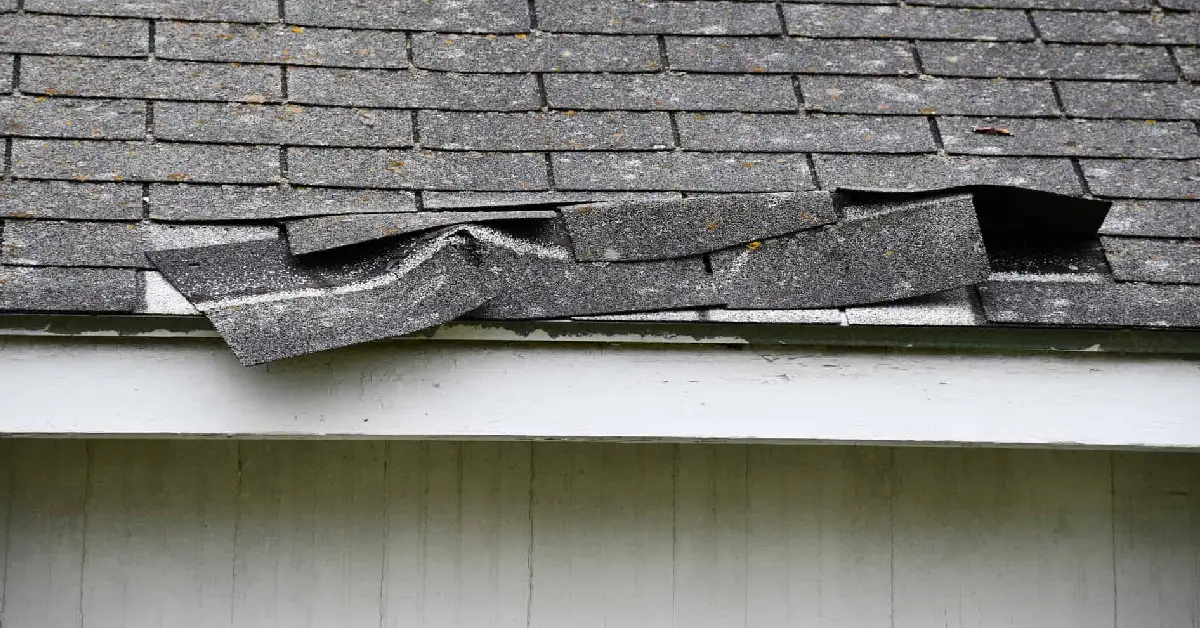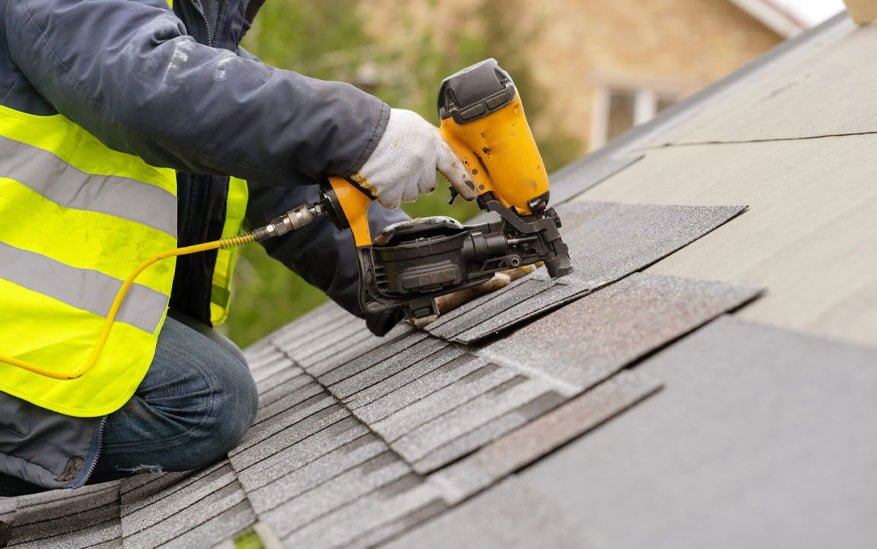When storm clouds gather, you first worry about your roof—can it stand firm against the incoming deluge? Protecting your home starts with proactive preparation for dangerous weather. You can protect your roof by:
- Scheduling inspections in spring and fall—and after major storms.
- Fixing structural weak points.
- Securing loose shingles and flashing.
- Keeping gutters and downspouts clean.
- Trimming branches that overhang your roof.
- Reviewing your roof and insurance plan before storm season.
Your roof is your home’s first line of defense against storms. As the outer shield, it takes hits from rain, hail, high winds, snow, and even lightning. Even a tiny gap—like a loose shingle or cracked flashing—lets water or debris inside, spreading damage across ceilings, walls, and your belongings. After the storm, you could face major repairs if small problems went unnoticed. Proactive upkeep—like sealing flashing, fixing shingles, cleaning gutters, and installing impact-resistant materials—helps your roof hold firm during any storm.
Schedule Regular Roof Inspections
The National Roofing Contractors Association states, “Good roof system maintenance is the single most important element you can implement to prolong the life of a roof.” Take better care now, and your roof will last longer. The NRCA recommends professional inspections at least twice a year—in spring and fall—and after major storms. Aim for inspections in early spring (after winter) and early fall (before colder months). Add extra checks after hail, wind, or heavy rain to catch damage early.
During a professional inspection, the roofer checks:
- Roof covering (shingles, tiles, membranes) for cracks, curling, granule loss, or missing pieces
- Flashing and seals around chimneys, vents, skylights, and parapets for rust, cracks, or lifting
- Downspouts and gutters for debris buildup or damage
They also inspect the attic and ceiling for moisture stains, mold, or rust spots, and look at the walls for water lines or bubbling paint. Finding issues early prevents leaks from spreading, reduces repair costs, and extends your roof’s lifespan. Skipping inspections leaves hidden damage unchecked, and that leads to surprise expenses and bigger repairs later. Stay proactive—schedule inspections twice a year, especially after storms, to protect your home.
Reinforce Your Roof’s Structure
In hurricane, tornado, hail, or heavy snow zones, reinforcing your roof structure helps prevent collapse and failure under extreme loads. Have a pro inspect your roof-to-wall connections, trusses, and decking for weak points like poor bracing or missing straps. They may recommend installing hurricane ties or clips, adding diagonal bracing, upgrading roof decking to thicker plywood, or using ring‑shank nails and H‑clips for stronger fastening.
Hurricane ties and connectors offer cost-effective, less invasive reinforcement. These galvanized steel straps create a continuous load path by linking roof framing, trusses, wall studs, and foundation. That gives lateral stability and resists uplift and shear forces from high winds and debris. By tying the roof peak to the foundation, you prevent twisting, lifting, and complete roof failure during storms. A retrofit of $2,500–$8,000 often recoups itself via insurance discounts and avoids catastrophic damage.
Secure Loose Shingles and Tiles
Loose, damaged, or missing shingles leave weak spots that deteriorate fast under rain and wind. During storms, those weak spots let water seep into the underlayment and roof deck. Over time, moisture spreads to support beams and sheathing, then into insulation and ceilings, often causing mold, rot, and costly repairs. Prompt roof repair prevents leaks from reaching your attic or walls, preserves structural integrity, and keeps energy bills and insurance headaches at bay.
Inspect your roof after every major storm—and at least once each season. Look for brittle, curling, or loose shingles and tiles—early signs that they could fail. After winds above 50 mph or hail, inspect from the ground (use binoculars) or hire a pro to spot cracked, missing, or displaced pieces. Gather fallen samples and note the manufacturer code stamped on the back—this helps you track down exact or close-match replacements.
Call a roofing pro with intact pieces— they can source discontinued shingles, arrange custom fabrication, or recommend suitable alternatives before colors fade. And remember: file any insurance claim within 30 days and keep debris as proof for matching-material coverage.
Replace damaged or missing shingles immediately—leaving gaps lets water and wind damage the underlayment and roof deck. Gaps let rain seep through to the underlayment and deck, then into beams and insulation, causing rot, mold, and higher repair costs. You can tackle small shingle fixes yourself—if your roof pitch is under 6:12 and heights stay below 12 ft—using fall protection and sturdy ladders. For steeper slopes, tall structures, or large sections, hire a pro to ensure safety and lasting results. Securing each shingle and tile before storm season gives you peace of mind—and prevents costly emergency repairs after high winds or hail.
Clean Gutters and Downspouts
Many roof failures during heavy storms come from interior flooding—not wind or hail—but clogged gutters and downspouts. When gutters can’t channel water away, rainwater and overflow overload your roof and siding. Standing water on your roof adds heavy stress. Just one inch of ponded water can cause up to $25,000 in damage. Moisture seeps beneath shingles, through flashing, underlayment, and into beams, leading to rot, mold, and structural damage.
To protect your roof during deluges, clean gutters, and downspouts at least twice a year—spring and fall—and after heavy storms. Use gloves, goggles, stable ladders, or hire a pro for safety. Gutter guards can reduce how often you clean, but they don’t replace regular maintenance—and some types worsen overflow—so weigh their pros and cons.
Clean gutters and downspouts at least twice a year—typically in spring and fall—or more often if heavy storms or trees surround your home. Remove leaves, nests, and debris by hand or with a gutter scoop. Flush with a garden hose or pressure washer using a telescoping wand—start away from downspouts and work toward them. Check that gutters slope toward downspouts and that extensions carry water at least 3 ft away from your foundation.
Reattach sagging sections using new hangers or brackets—proper pitch prevents pooling and damage. Use a plumbing snake or pressure washer to clear downspout blockages from the bottom up. Restoring full gutter and downspout function helps prevent ponding. Just one inch of standing water can cause up to $25,000 in damage.
Remove Debris and Trim Trees
Ignoring debris build‑up and overgrown trees jeopardizes your roof nearly as much as clogged gutters in a storm. Tree debris—like leaves, twigs, and seeds—traps moisture, blocks gutters, and spikes your risk of rot and mold. Falling branches can scratch, crack, or puncture shingles, while shaded areas under heavy canopy promote moss and algae growth that degrade roofing materials. Both risks are preventable with regular landscape upkeep—prune branches back at least 10 ft from your roof, clear debris off the roof and from gutters, and schedule seasonal pruning to cut damage risk by up to 80%.
Walk around your home to spot trees with untrimmed branches reaching toward your roof. Storms can push overgrown limbs into the roof space, scraping shingles or breaking tiles. ‘Widowmaker’ limbs—dead or unstable branches—can scrape or puncture your roof during storms, creating holes that let in water. Trim branches at least 6 ft from the roof—and ideally 10–20 ft for tall trees—to prevent contact. Prune trees in late winter for safer cuts and faster healing. Removing branches within 10 ft reduces debris and damage risk by up to 80%. Use a certified arborist to remove widowmakers—they fall unpredictably and can be deadly. Clear fallen branches and debris around your home—these can fly or roll onto your roof in high winds.
Clearing debris and trimming vegetation reduces the risk of airborne projectiles—like branches, shingles, or loose attachments—damaging your roof during storms. Shingles and tiles can fly at speeds close to gust wind velocity, and debris impact causes up to 40% of roof failures. Even a single branch strike can lead to $2,000–$10,000 in repairs, plus water intrusion and mold. Even small prevention steps pay off in long-term protection and help avoid major repair bills.
Prepare for Storm Season

As climate change intensifies weather patterns, every location now sees amplified risks from seasonal storms, spanning destructive hurricanes, flooding downpours, and tornado swarms peppered with damaging hail assaults. Homeowners must evolve vigilance and preparatory action to match the amplified threats targeting every roof.
Ahead of peak storm windows, thoroughly walk around your house to spot any developing trouble signs. Scan shingles and tiles for emerging cracks or curling indicative of erosion requiring restoration. Note areas where joints, interfaces, or seals show separation that could enable deeper water intrusion if left uncorrected. Document any sections bearing signs of subsurface seepage like exterior walls showing water stains. Verify all siding remains properly integrated with flashing seals to prevent wind-ripping material off to create new gaps. Document any protrusions from ventilation fixtures or the like that could catch wind like a sail and torque the roof from its stable mooring.
Preparation also calls for programming your local emergency responders into all household members’ phones. This ensures everyone can rapidly report dangerous situations like a tree crashing onto the roof or a similar crisis requiring rapid response ahead of a wider catastrophic failure from the initial damage. With maintenance and vigilance covered, and emergency contacts prepped, you can weather whatever turbulence comes carried on the winds this stormy season.
Conclusion
Your home’s roof safeguards everything within its walls from exterior assaults by the elements. Yet this protective barrier only remains effective if properly supported with ongoing maintenance and timely repairs. By following the National Roofing Contractors Association’s guidelines for professional biannual roof inspections, reinforcing structural stability, meticulously securing every shingle and tile, clearing leaves from drainage systems, removing overgrown trees and debris, and planning emergency response ahead of storm seasons, homeowners provide their roof the best probability of weathering whatever turbulence the forecast serves up next.
Do not leave your most valuable asset’s resilience to chance against the strengthening swings of Mother Nature’s storm cycles. Through proper care, your roof can continue defending your home from the elements for decades to come.
FAQs
Why is roof maintenance important?
Regular roof maintenance is critical to ensure your roof remains in good condition and can withstand severe weather events like heavy storms, high winds, hail, or heavy snow. Routine inspections and repairs prevent minor issues from becoming major roof failures down the line.
How often should I have my roof inspected?
Industry experts recommend having your roof professionally inspected at least twice per year. Schedule inspections in early spring and late summer to examine your roof before and after seasons of active storm threats.
What are signs I may need roof repairs?
Watch for damaged, loose, or missing shingles/tiles, leaks, water stains on interior ceilings and walls, visible sagging areas of the roof, damaged flashing around vents/chimneys, obstructed gutters, and overhanging tree branches. Address any issues promptly.
Should I reinforce my roof structure?
In areas prone to severe storms, having a roofer assess whether added supports, hurricane ties, connectors, or extra fasteners could bolster your roof against extreme winds and impacts is wise. These affordable reinforcements prevent roof twist/lift-off.
How can I prepare my roof for storm season?
Clear debris from the roof and gutters, trim back overgrown trees, check for aging/damaged roof materials and secure as needed, ensure flashing seals are intact, and program emergency responder contacts in your phone ahead of forecasted storms.
When should I hire a professional vs. DIY roof repairs?
You can likely handle minor repairs like replacing a few loose shingles yourself. However extensive repairs, steep roofs, multi-story heights, and unknown leak sources often benefit from a certified professional roofer for safety, proper diagnostics, and reliable solutions.


